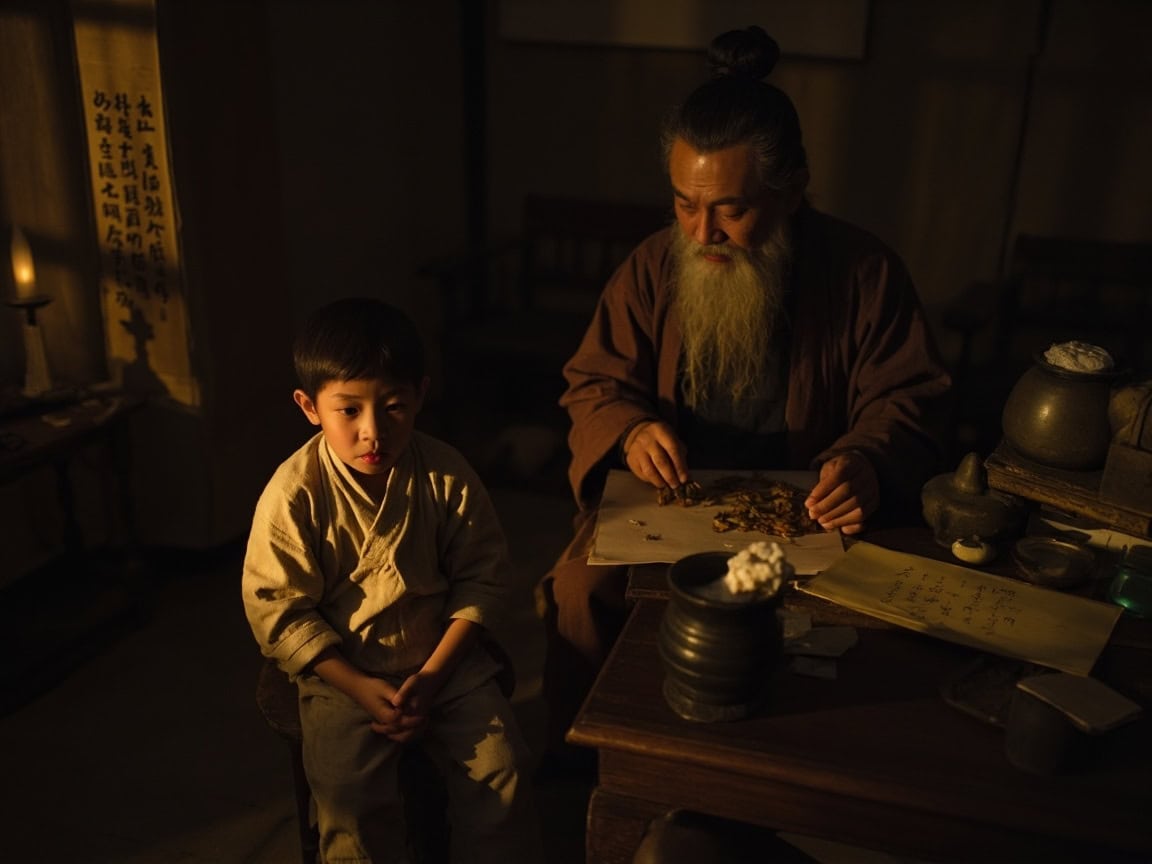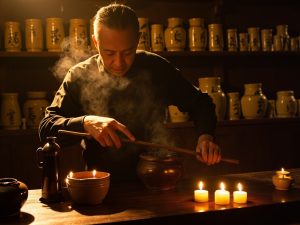Table of Contents
ToggleTraditional Chinese Medicine Case Analysis 5:Diabetes Insipidus, Xiao Ke (Wasting-Thirst Syndrome)
Author: Gu Yuxi Editor: Gu Yuxi Translator: Gu Yuxi
Traditional Chinese Medicine (TCM) Case Study from Li Keshao’s [Wuling Powder for Treating Xiaoke (Diabetes Insipidus) Case Study] in “Luo Jiao Annotation of Guilin Ancient Edition of Shanghan Zabing Lun“
Original Text:
Wang, male, 7 years old, consulted on July 13, 1975. The child suffered from polydipsia and polyuria. A local hospital examination showed a urine specific gravity of 1.007, diagnosing it as “diabetes insipidus,” with no effective treatment. The consultation revealed no abnormalities in his complexion or pulse, but his tongue was pale with a white, slippery coating, resembling a thin, uneven layer of paste. It was considered that this condition might be due to the internal accumulation of water-dampness, obstructing the transportation and distribution of jinye (body fluids), leading to thirst and a desire to drink, but drinking did not quench the thirst. The polyuria was merely a result of the polydipsia, an induced symptom. If his thirst could be reduced, the urine output would naturally decrease. Therefore, Wuling Powder was prescribed: Atractylodes macrocephala 12g, Poria 9g, Alisma 6g, Ramulus Cinnamomi 6g, Polyporus 5g. Decocted in water. (Shanghan Jichu Lun)
Annotator’s Commentary: A white, slippery tongue coating is a key characteristic for identifying internal retention of water-dampness. When water-dampness is retained internally, jinye cannot be distributed, leading to thirst. Excessive drinking then leads to excessive urination. Clinically, it’s important to assess the situation and grasp the main symptoms, rather than waiting for all symptoms like difficulty with urination and fever to be present before applying Wuling Powder. Of course, if xiaoke presents with a red tongue with little coating and a thin, rapid pulse, it indicates yinjin deficiency, and this formula should then be contraindicated.
【Traditional Chinese Medicine Syndrome Differentiation Approach】:
Differentiating Six Diseases:
- Difficulty with urination : Possibly present. Polydipsia and polyuria. At least here, the characteristics of urination might be different from a normal person.
- Taiyang Disease : None.
- Yangming Disease : None.
- Shaoyang Disease : None.
- Shaoyin Disease : None.
- Taiyin Disease : None.
- Jueyin Disease : None.
Differentiating Miscellaneous Diseases:
- Qi Deficiency : None.
- Blood Deficiency : None.
- Water-Dampness : Present. Pale tongue with a white, slippery coating, like a thin, uneven layer of paste.
- Food Stagnation : None.
- Phlegm Obstruction : None.
- Blood Stasis : None.
- Other Miscellaneous Diseases: None.
Summary:
It can be affirmed that there are no signs of the Six Diseases (Shanghan Six Divisions). There are also no miscellaneous diseases like qi deficiency, blood deficiency, food stagnation, phlegm, or blood stasis. Water-dampness is present based on the tongue coating, and the treatment method requires diuresis. Difficulty with urination may be present (too much or too little urine can both be considered difficulty with urination). From the treatment principles, many unusual diseases without specific symptoms are often suggested to try diuresis. The pale tongue color indicates that it is definitely not a severe heat syndrome, and it might suggest a slight deficiency of yang qi. Therefore, a diuretic classical formula with a broader diuretic scope that leans towards yang properties – Wuling Powder – was chosen.
Shanghan Zabing Lun Clause Corresponding to This TCM Case:
Differentiating Yangming Disease Pulses and Treatment 9.68 – [9.68] In Taiyang disease, if the inch pulse is moderate, the cubit pulse is floating, and the proximal pulse is weak, and the person has fever and sweating, and also aversion to cold, but no vomiting, only epigastric fullness, this is due to the physician purging them. If they were not purged, and the patient has no aversion to cold but is thirsty, this indicates a transformation to Yangming. If urination is frequent, the stools will be hard, and if there is no bowel movement for ten days, there is no distress. If thirsty and desiring to drink water, give a small amount, and rescue them according to the method; if thirsty and drinking a lot of water, and urination is difficult, Wuling Powder is suitable.
The symptom “thirsty and drinking a lot of water” in this clause is consistent with the symptoms in the case study above. “Urination is difficult” is not entirely consistent; the case study showed polydipsia and polyuria, with a certain possibility of difficult urination. Anyway, abnormal urination (too much or too little) can be considered difficult urination. Additionally, the tongue coating helps differentiate and confirm the presence of water-dampness, and it might be water-dampness of Taiyang disease.
Hu Xishu’s Interpretation of This Clause:
Originally, it was Taiyang disease. A moderate inch pulse means that jinye is insufficient externally. A floating and moderate pulse, according to the ancients, is a sign of wind-stroke, meaning Taiyang wind-stroke. Slowness and weakness, like a weak proximal pulse, indicate blood depletion, meaning low blood volume, hence a slow pulse. Coupled with a floating cubit pulse. In short, it is a floating and moderate, or floating, moderate, and weak pulse, which is the pulse of Taiyang wind-stroke. Why did Zhang Zhongjing differentiate it this way? He had his intentions. The cubit pulse corresponds to the stomach, which is the epigastric region; a floating pulse primarily indicates heat, it also indicates exterior and heat. “Cubit floating” indicates epigastric fullness, and this fullness is due to heat, which is treated with Xiexin Tang (Drain the Epigastrium Decoction). So he uses the pulse and its location to explain the pathological condition.
It’s difficult to differentiate between a moderate pulse and a weak pulse. “Moderate pulse” refers to a relaxed pulse. As for “weak pulse”? Weakness is relative to tautness; a “taut pulse” is straight and rigid, like a bowstring. So “weak pulse” refers to a weak pulse when pressing down, unable to withstand pressure. Theoretically, there is a distinction between moderate and weak, but it is difficult to differentiate with the fingers. Therefore, in Zhang Zhongjing’s writings, moderate and weak pulses are used interchangeably. He says that in Taiyang wind-stroke, “fever, sweating, aversion to wind, moderate pulse.” When discussing the treatment of Taiyang wind-stroke, he also says “Yang floating and Yin weak,” again mentioning “weak.” This shows that it’s difficult to differentiate between a moderate and weak pulse by hand, though a theoretical distinction between moderate and weak exists.
“The person has fever and sweating, and also aversion to cold” – this is the symptom of Taiyang wind-stroke. Taiyang wind-stroke involves fever, sweating, and aversion to cold. “No vomiting” means it hasn’t transmitted to the half-exterior half-interior, so there’s no Chaihu syndrome.
“Only epigastric fullness” – it also hasn’t transmitted to Shaoyang, no hypochondriac fullness, no chest and hypochondriac discomfort, but “only epigastric fullness.” The epigastric region is blocked and obstructed. Looking at the situation, the exterior hasn’t been resolved, and there is epigastric hardness. This is probably a problem caused by “physician purging them.” Purging while the exterior is unresolved leads to external evil entering internally, hence epigastric fullness. This is probably the situation.
The first paragraph describes the situation mentioned above. However, he didn’t give a treatment method. It’s usually present earlier; one should first use Guizhi Tang (Cinnamon Twig Decoction) to resolve the exterior, and then Xiexin Tang to treat the fullness, or Dahuang Huanglian Xiexin Tang (Rhubarb and Coptis Drain the Epigastrium Decoction), or Sanhuang Xiexin Tang (Three Yellows Drain the Epigastrium Decoction). I use Sanhuang Xiexin Tang more often. This is one section.
“If they were not purged, and the patient has no aversion to cold but is thirsty, this indicates a transformation to Yangming.” “If they were not purged,” this patient no longer has aversion to cold – earlier it said fever, sweating, and also aversion to cold – no aversion to cold, just epigastric fullness and thirst, that’s a transformation to Yangming. Thirsty because there’s internal heat. The fullness isn’t a big problem; it’s not severe repletion, just a slight internal repletion, not major. So he says “transformation to Yangming.” Transformation to Yangming means Taiyang transforming to Yangming. The Taiyang disease hasn’t ended; transformation is a parallel term for co-occurrence, and transformation is also a co-occurrence, but Taiyang disease is about to resolve, as they no longer have aversion to cold, and are also thirsty, so Yangming disease is already evident.
“If urination is frequent,” at this time, urination is very frequent, so the stools must be hard. But hard stools don’t cause delirium, the heat inside isn’t too severe. “No bowel movement for ten days, there is no distress.” This is what we said earlier, jinye depletion causing hard stools, solely due to frequent urination. Although no bowel movement for ten days, there’s no distress, implying that one should not attack it! We can also use methods for “desiring to defecate,” like Maziren Wan (Hemp Seed Pill) for spleen-constraint, depending on the severity of the illness. If severe, with some heat, Maziren Wan can be taken, which is now referred to as Maziren treating the spleen. Otherwise, one would need to use guiding methods, like honey suppositories or pig bile enemas.
If they are “thirsty and desiring to drink water,” then “give a small amount, and rescue them according to the method.” Give small amounts of water, don’t let them drink too much, or they will surely gasp for breath. They don’t have much heat, give water bit by bit. Due to frequent urination, jinye is lost, and if the stomach recovers, they will heal.
The “thirst” here refers to the thirst mentioned in the preceding two paragraphs. The first paragraph, “after purging,” still has unresolved exterior heat and epigastric fullness. This type of epigastric fullness is due to water retention, and Wuling Powder syndrome is present. Due to purging, qi rushes upward, causing difficult urination. This (difficult urination) is definitely not frequent urination. Difficult urination, slight heat and thirst, that’s Wuling Powder syndrome. This epigastric fullness is precisely water qi counteracting in the epigastrium, but why didn’t he elaborate?
This is a concise text. Placing “thirst” here represents it; it was mentioned earlier. This connects to the first paragraph, “this is due to the physician purging them.” The second paragraph, “if they were not purged,” can also lead to such symptoms, i.e., the patient has slight heat, no aversion to cold, and is thirsty. This hasn’t transformed to Yangming, there’s no subsequent part about “this indicates a transformation to Yangming. If urination is frequent, the stools will be hard, and if there is no bowel movement for ten days, there is no distress.” It hasn’t transformed to Yangming, but they have difficult urination, and this type of thirst is also due to stagnant water, and Wuling Powder can also be used.
He expands on “thirst,” not saying that if “transformed to Yangming and urination is frequent,” you should still take Wuling Powder. That’s incorrect. We’ve already discussed Zhuling Tang (Polyporus Decoction) with specific explanations for these situations. If jinye has been lost to this extent and transformed to Yangming with frequent urination, you cannot take Wuling Powder anymore.
Wuling Powder cannot treat frequent urination. Wuling Powder has a very strong diuretic effect, and this is a Yangming disease. If it truly transmits internally to Yangming, Guizhi does not treat internal heat. Therefore, there is a lot of debate about the last section of this clause. I believe that “thirst” is a new point, not a continuation of the preceding ones, not implying “give a small amount, but the thirst persists.” That’s not it. If the stools are already hard, you should not continue to promote urination. Repeatedly promoting urination is not advisable. Even Zhuling Tang cannot be used, let alone Wuling Powder.
This is a concise text. Why didn’t he elaborate? Because it was already explained earlier. You can go back and look at the sections on Wuling Powder mentioned earlier to understand.
Formula: Wuling Powder
Source: Shanghan Zabing Lun
Composition in Guilin Edition: Polyporus 18 zhu (peeled) Alisma 1 liang 6 zhu Poria 18 zhu Ramulus Cinnamomi 0.5 liang (peeled) Atractylodes macrocephala 18 zhu The above five ingredients are pounded into a powder. Take one fangcunshi (spoonful) with warm rice water three times a day. Drink plenty of warm water, and sweating will lead to recovery.
Composition in Song Edition: Alisma 1 liang 1 fen Polyporus 3 fen (peeled) Poria 3 fen Atractylodes macrocephala 3 fen Ramulus Cinnamomi 2 fen (peeled) The above five ingredients are pounded into a fine powder. Take one fangcunbi (spoonful) with rice water three times a day. Drink plenty of warm water, and sweating will lead to recovery.
Hu Xishu’s Dosage:
Polyporus 9g, Alisma 9g, Atractylodes macrocephala 9g, Poria 9g, Ramulus Cinnamomi 6g.
Hu Xishu’s Formula-Pattern Correspondence:
The thirst in Wuling Powder syndrome has two reasons: one is due to difficult urination. The other is that heat is not dispelled, there is heat. And the various tissue cells lack water nourishment, so they are thirsty, and at the same time, they have heat, leading to vexing thirst. These two factors combine to form “slight heat and xiaoke,” which is Wuling Powder syndrome. When we use Wuling Powder, on the one hand, it resolves the exterior – by promoting diuresis and resolving the exterior, it dispels the heat – and at the same time, it facilitates urination, including the entire restoration of water metabolism function. When the old water is gone, new water is naturally absorbed, and the thirst will be gone.
Wuling Powder combines Poria, Polyporus, Alisma, and Atractylodes macrocephala, which are all diuretics, and is compounded with a small amount of Ramulus Cinnamomi; notice that only half a liang of Ramulus Cinnamomi is used. Our difficult urination is often due to qi rushing upward, so many diuretics are compounded with Ramulus Cinnamomi. Ramulus Cinnamomi calms the upward rushing qi, preventing qi from rising, as qi overwhelming the upper part often induces water to go upward instead of downward. Additionally, the combined strength of diuretics achieves urination downwards. Wuling Powder is a very important formula among diuretics.
Polyporus is quite strong in its diuretic effect, and at the same time, it also quenches thirst while promoting diuresis. It is a cold-natured diuretic. If urination is accompanied by thirst, Polyporus is often used. Alisma is a sweet and cold herb, also a cold-natured diuretic. Being sweet and cold, it enters the stomach, so it’s used for water retention in the stomach. Atractylodes macrocephala also enters the stomach; Atractylodes macrocephala is slightly warm. Alisma is slightly cold. If there is water retention in the stomach, and it’s not very cold, but rather has heat, use Alisma. Any water in the stomach can cause dizziness; Alisma and Atractylodes macrocephala both treat dizziness, so they are not only diuretics but also treat dizziness. Clinically, for dizziness due to internal water retention, we also use diuretics. For difficult urination with dizziness, I often use Atractylodes macrocephala and Alisma.
Poria treats palpitations, vexation, and muscle twitching; Poria is used for all of these. It also promotes diuresis and enters the stomach. Poria is very mild in nature, so it is commonly used in diuretics, especially for what we now call neurosis, for neurological diseases caused by water retention, Poria is often used. Look at sleep aids, Suanzaoren Tang (Sour Jujube Seed Decoction) also uses a large amount of Poria; you can’t do without Poria. It is most frequently used for neurological diseases, especially palpitations and heartbeats. Not only palpitations and heartbeats, but also twitching in other areas.
Wuling Powder, with a small addition of Ramulus Cinnamomi, can both resolve heat, promote diuresis, quench thirst, and of course, treat dizziness. Wuling Powder uses a relatively complete range of diuretics. Nowadays, Wuling Powder is also available in powder form, but decoctions are more commonly used. Generally speaking, for decoctions, the first four ingredients can all be used at 9g, and Ramulus Cinnamomi at 6g. However, for water reversal (shui ni), powder form is better; decoctions are not very suitable. This conclusion is drawn from clinical observations.
Wuling Powder syndrome initially presents as xiaoke with difficult urination and fever, slight fever. Taking Wuling Powder at this time will resolve it and prevent water reversal. If delayed further, and urination is not facilitated, and water is continuously consumed to a considerable extent, drinking more will lead to vomiting. This is called water reversal. Water reversal is a continuation of Wuling Powder syndrome, so Wuling Powder is still used.
Disclaimer:
The experiences and insights shared above represent the author’s personal usage and understanding, and are provided for reference only as part of academic exchange. Please do not blindly replicate or apply them; any consequences arising from such actions are solely your responsibility. As individual constitutions vary, medication should be tailored accordingly. It is advisable to use such treatments under the guidance of a qualified physician. If you have additional experiences to share, comments and submissions are welcome.
If you appreciate my article, please give it a like.
If you are a generous and affluent individual, please consider making a donation!
Your recognition is my greatest motivation to continue writing—thank you very much!
USD Donation Button —
A RMB donation button is available below.
 微信赞赏
微信赞赏 支付宝赞赏
支付宝赞赏




